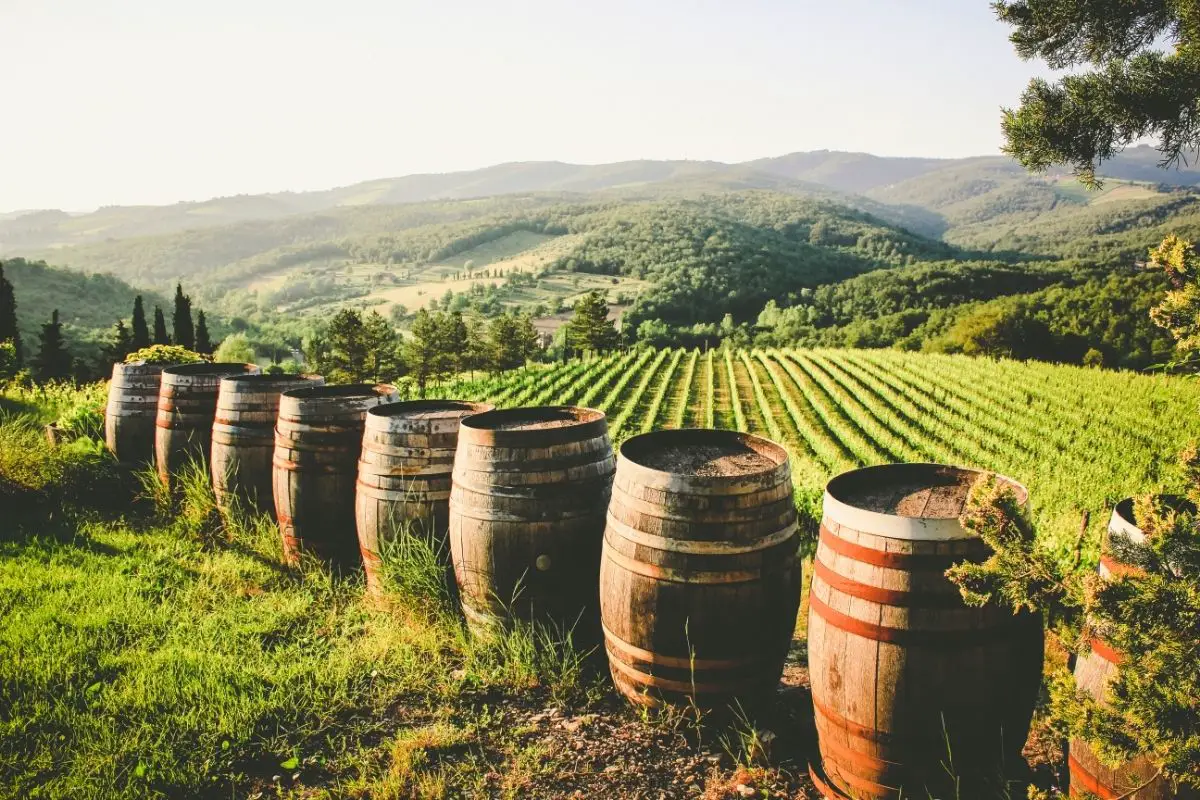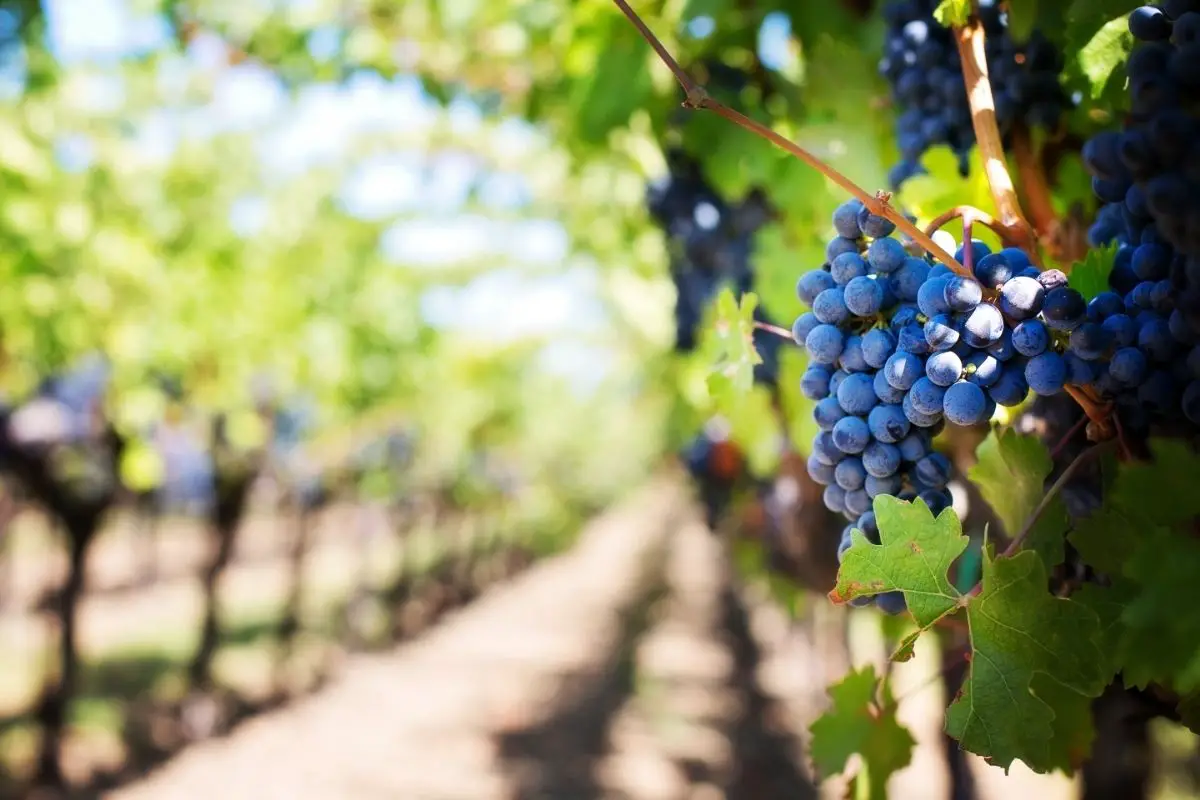Perhaps when you are driving around, you might see a sign for a winery or a vineyard. Maybe you might be tempted to visit, especially if you love wine. You may have heard that some wineries offer tastings and tours. However, what is the difference between a winery and a vineyard? Maybe you think that they are the same thing, but they’re not and in this article, we will show you what the differences and similarities are.
What are the Most Important Differences Between Wineries and Vineyards?
- A vineyard is a tract of land where grapes are grown for wine production. A winery produces wine and often opens its doors to the public for wine tastings.
- A winery may have a vineyard attached to it or they might purchase grapes from vineyards. Vineyards often just sell their grapes to wineries and don’t have a winery on their land.
More About Vineyards
We have already said that vineyards produce grapes to make wine. However, some also produce eating grapes, raisins, sultanas, and non-alcoholic grape juice.
The History of Vineyards
Wine has been around for literally thousands of years. The oldest evidence of grape-growing goes back to 6000 B.C. when a piece of pottery was found in Georgia that was stained with wine.
The Phoenicians brought vines to the different countries they conquered both in the years B.C. and A.D., as did the Romans. The Romans were the first to develop wine making techniques that are used today. In the Middle Ages, the Church and nobility took over most of the vineyards and introduced new grape varieties.
How Does Terroir Affect Grape-Growing?
Terroir is the natural environment where grapes are grown. It includes factors such as soil, altitude, climate, and topography. All of these affect the aroma and flavour of the wine. Because of this, wines from different vineyards will not be the same. In addition, if it is a large vineyard and covers different topographies and soils, the wines from the same vineyard may not taste quite the same.
Many vineyards are built on hillsides, usually facing north or south. This means that they get the maximum amount of sunshine. Quite often you will see vineyards on hillsides in a dry climate and facing south.
The soil on these hillsides is usually not that good and is useless for other crops. However, these soils are surprisingly beneficial for grapes. Grapes can grow in many different soils, but sandy loam is the best. It drains well and contains some nutritious organic matter and falls in the right PH range.
If the vineyards are in wet regions, they need to have good drainage otherwise there could be flooding and the vines will be ruined.
What is a Vignette?
A vignette is obviously a French word and it is a 500 square metre vineyard that is within a larger vineyard. You may find that large vineyards have many of these small vineyards within their boundaries. The idea behind this is that people buy these small vineyards and work under a co-op structure. They outsource the grape maintenance and production to an outside grape grower or winery. The cost of production is usually low and labour is cheap.
More About Wineries
Wineries produce wine and may have vineyards attached to them or otherwise, they buy the grapes from other vineyards. They employ a winemaker who is in charge of all proceedings starting with communicating with viticulturists, supervising the crushing of the grapes, monitoring the whole fermentation process, putting the wine in casks, and later bottling it. Many wineries allow the general public to visit and taste the wine. Sometimes, you can have a meal with the wine tasting, and there is always the opportunity to buy the wines.
Are There Different Types of Wineries?
Yes, there are different types of wineries and we’ll take a look at them here.
What is a Vineyard Winery
This is the most common type of winery out there. It has a vineyard attached to it and quite often, it is a family business, especially in Europe. The grapes are grown here, harvested, crushed, fermented, left to age, and then poured into bottles for sale. Wine produced in these wineries are called Estate wines. An Estate wine can come from different vineyards as long as they are owned by the winery that bottles it. A single-vineyard wine is, on the other hand, made from a vineyard that is not owned by the estate.
What is an Urban Winery?
Urban wineries are all the rage now especially with wine producers who don’t have room to grow their own grapes. They choose to set up their wine-making facilities in an urban setting rather than in a rural one. They ship in their grapes from different vineyards. Some of these https://jccdallas.org/ pills vineyards may even belong to them. Most of these wines are sold in supermarkets and off-licences.
What is a Farm Winery?
Farm wineries are similar to traditional wineries in that the vineyards are attached to the wineries. However, the owners always live on site and grow other crops. They usually sell their wines on site and you probably won’t find them in many shops.
What is a Venue Winery?
Many venue wineries do produce wine, but not all. Instead, they buy from other wineries. Their purpose is to hold big events such as weddings, corporate events, and special occasions such as anniversaries and birthday parties. They usually have a large hall holding dozens of people . However, with covid regulations, you may not be able to have as many people as you want.
Some venue wineries have large outdoor areas and may put on concerts or hold festivals.
What is a Destination Winery?
Perhaps you would like to spend a relaxing day sipping wine or maybe you want to get away to the countryside for a few days at a location where there are stunning views. If you enjoy wine, then head to a destination winery. You will be impressed with the scenery and the relaxing pace of life. Some destinations offer bed and breakfast so you can extend your stay.
A Summary of the Differences Between a Winery and a Vineyard

By now you should be aware of the differences between a winery and vineyard, but we’ll summarise them here.
1.A winery is where wine is produced. This process involves the fermenting of the grapes, as well as the blending and ageing of the juice. Sometimes they are attached to vineyards and this may be a family affair. Other times, they buy grapes from vineyards. Usually, they are situated in the countryside, but there has been an increase of wineries in urban areas. They buy their grapes from vineyards. Some families have farms where they have vineyards and produce wine, and also grow other crops.
A vineyard is a plot of land where grapes are grown to not only produce wine, but to sell the grapes for eating. They may also produce dried fruits like sultanas and raisins. Vineyards can be small or big ranging from a few acres to the 5700 acres of the Plantaze vineyard in Montenegro which is the largest vineyard in the world. Sometimes, investors will buy a small acreage of land in a vineyard in order to produce their own wine. There are no restrictions on the types of grapes grown in any vineyard.
2. The purpose of a vineyard is to produce grapes while the purpose of a winery is to produce wine. Wineries can be so much more however as they often open their doors to the public for wine tasting and many just allow you to come in to buy bottles of their wine. They often do tours as well so that you can learn about the winemaking process.
3. Wineries may not have vineyards attached to them and in the same way, vineyards may not have wineries attached to them. However, it is often the case that wineries and vineyards are connected to each other, especially in regions which are frequented by tourists. It is an advantage for them as tourists may become some of their best customers in the future. It is definitely a money-making opportunity and what’s wrong with that?
Frequently Asked Questions
We hope that you have enjoyed reading about wineries and vineyards, but perhaps you have some questions. If so, we’ll answer some questions that we are often asked.
Are there any differences in producing red wine compared to white?
The major difference is that white wine doesn’t have much skin contact. After harvest, the grapes are pressed directly, separating the must from the grape skins before the fermentation process begins. This is why the wine is white. To produce red wine, red and black grapes are used and the grape skins are kept on. This gives the wine a red colour.
Do Vineyards Last Forever?
As with everything, vineyards will last longer if they are looked after properly. For example, fencing helps them grow straight and firm. It is a good idea if the grape vines are trimmed regularly as this helps to get a better yield of grapes. The location of the vineyard is important. It must have some sunlight and if it rains, there should be adequate irrigation in place. If you do look after your vineyards properly, they can last for up to 100 years or even longer. There are some vineyards in the U.S. that were planted in the 1880s.
In What Way is Wine Classified?
Wine is classified according to the grape used to produce the wine and also by the region and country it comes from. Wines that are classified by grape variety are called varietals and those classified by region are named after the region.
Where Did the Name Vineyard Come From?
France is considered to be at the heart of winemaking. The French name for a vineyard is vignoble and this was translated in England to wineguard in the 14th century. Eventually this word changed to vineyard. However, in South Africa, vineyards are known as wine farms.
Summary
Maybe you are thinking that it doesn’t matter knowing much about the differences between a vineyard and a winery, but if you are a wine connoisseur you may want to impart your knowledge to others.
The differences are quite simple so it’s not too difficult to remember them. Basically, a vineyard is where grapes are grown and a winery is where wine is produced. Sometimes they exist separately and quite often you get a winery with vineyards attached to it.


